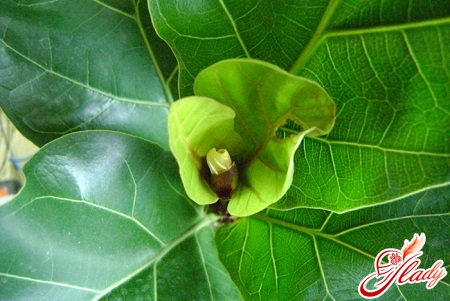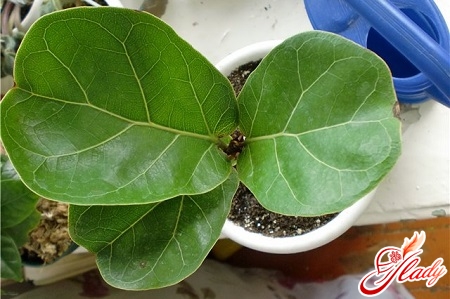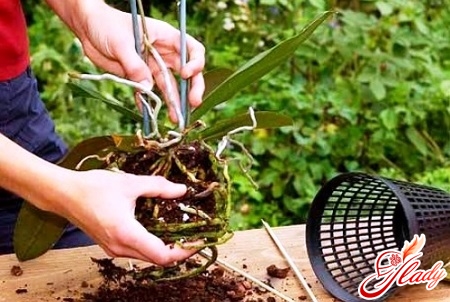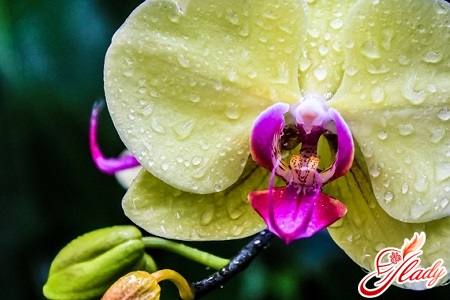 The ficus has long since become uniquesymbol of home comfort. However, not everyone knows that there are quite a few types of indoor ficuses. Among them are babies and giants, spreading, tree-like, handsome and very slender specimens. There are variegated species and even ficuses similar to Japanese bonsai. So one of the popular types of indoor ficuses was and remains the lyre-shaped ficus. What kind of plant is it, how should it be cared for, and is it possible to reproduce it at home, we will try to find out.
The ficus has long since become uniquesymbol of home comfort. However, not everyone knows that there are quite a few types of indoor ficuses. Among them are babies and giants, spreading, tree-like, handsome and very slender specimens. There are variegated species and even ficuses similar to Japanese bonsai. So one of the popular types of indoor ficuses was and remains the lyre-shaped ficus. What kind of plant is it, how should it be cared for, and is it possible to reproduce it at home, we will try to find out.
Botanical description
Ficus lyrata has received itsname for the unusual shape of the leaves, which resemble a lyre or a violin. By the way, another common name for this plant is ficus violin. The resemblance to a musical instrument is given to it by the characteristic pattern of light veins on the dark green of the leaf, similar to strings. This plant is from the mulberry family, whose homeland is tropical Africa. In nature, it looks more than impressive, reaching a height of thirty meters. In fact, its large size is the main difference between ficus lyrata and other types of ficus. Another of its distinctive features is its wavy leaves, which give the plant a special decorative effect. This is an evergreen tree, which can grow up to two and a half meters in height in indoor conditions. And in nature, these trees are able to exist in tropical thickets as epiphytes, striving for sunlight. The leaves of the lyre-shaped ficus are also quite large - up to half a meter long and up to forty centimeters wide. The surface of the leaves is leathery and glossy, and the leaves themselves are planted on a small petiole and arranged on the stem in a spiral. The most famous varieties of this species are:
- Columnaris - a tall columnar plant;
- Bambino is a miniature variety with compact leaves;
- Little Fiddle is a medium-height plant.
The main differences between varieties are heightplants, compactness of the crown and size of the leaves. But, regardless of the variety, this ficus is one of the most elegant and spectacular types of domestic ficus. By the way, caring for it is somewhat more difficult than for other ficuses.
Conditions of detention
Comfortable conditions for the plant- one of the conditions for its successful cultivation. The lyre-shaped ficus can even be called a capricious plant, since under unfavorable conditions it immediately begins to shed its leaves and loses its decorative effect. And comfortable conditions - these are conditions close to natural. First of all, you need to choose a suitable place for the ficus. And this plant loves light, so the room where the flower grows should be well lit, but the plant itself must be protected from direct sunlight. The most suitable place for placing a flower pot will be windows facing west or east. On northern windows it will not have enough light, and on southern windows the plant will have to be shaded. Direct sunlight can cause leaf burns, and with insufficient lighting, leaves may fall off, internodes and branches may stretch, and the growth of the ficus will noticeably slow down. The temperature regime should also be as close as possible to the natural - tropical. The most suitable temperature for growing ficus will be a range of 20-25 degrees Celsius in summer and 15-20 degrees Celsius in winter. But in any case, the room temperature should not fall below 12 degrees Celsius. Keep in mind that this flower reacts painfully to sudden temperature changes - brown spots appear on the leaves. Ficus also does not tolerate hypothermia of the soil well, so it is not recommended to put it on cold windowsills and should be protected from drafts. As for the humidity in the room where the ficus grows, it should be high (the tropics are the tropics!). Regular year-round spraying of the flower and washing its leaves will help maintain the desired humidity regime. Periodic showers are also useful for the lyre-shaped ficus, especially in the hot summer months. You can also put a wide container filled with water next to the pot and try to protect it from dry and hot air flows.
Care
Caring for any indoor plants comes down totimely and sufficient watering, regular fertilizing and replanting plants as needed. And what kind of care should a violin ficus have?
- Watering
A structured watering regime for this plantIt is difficult to choose. The fact is that its need for moisture depends on the size of the plant, and the room temperature, and the degree of dryness of the air, and the lighting, and the season. Naturally, in the summer the plant requires more intensive moisture than in the winter. However, it is necessary to focus on the drying of the soil in the pot. The soil should not be constantly moistened - in between waterings it is necessary to let it dry out. Important! At any time of the year, you need to water the violin fig only with soft water, which must first settle well. If you water the plant with hard (enriched with salts and impurities) water, then white spots will appear on its leaves - salt stains. Another condition for proper watering is to use only warm (or room temperature) water and watering from above the soil, in which its surface should be evenly moistened. Twenty to thirty minutes after watering, the water that has flowed into the tray must be drained, and the bottom of the pot and the tray must be wiped dry.
- Feeding and transplantation
The violin ficus needs periodictransplantation, as it is a fast-growing indoor flower. The first two or three years, it must be replanted every spring. After four years of age, transplantation is carried out less often - once every two years. A signal about the need for transplantation is the degree of filling of the flower pot with roots - when the roots fill it completely, the plant needs to be moved to a new container. The new pot should be two to three centimeters larger in diameter than the previous one. Transplantation is carried out by transshipment, preserving the old lump of earth and filling the voids between the lump of earth and the walls of the pot with a new soil mixture. This method is recommended in order to preserve the root system of the plant. For young ficuses, you need to take a soil mixture consisting of peat, sand and leaf soil in equal proportions. The soil for adult specimens is supplemented with turf soil or humus. If you do not have the opportunity to make up the soil mixture yourself, you can buy ready-made soil designed specifically for growing ficuses. Fertilize the lyre-shaped ficus once every two weeks. In this case, use liquid complex fertilizers in a concentration half that recommended on the package.
- Reproduction
If you have a desire to multiply yourwonderful ficus, then it is quite easy to do. The reproduction of the lyre-shaped ficus is carried out by cuttings, using stem or leaf cuttings. Cuttings ten to fifteen centimeters long are cut with a sharp knife (not scissors!) at an angle. Milky juice will be released at the cut site, which must be washed off with running water, and the cutting left to dry for two to three hours. Then the cut cutting is placed in a container with water, in which one tablet of charcoal is dissolved. Roots on the cutting appear after a month. During this time, it is necessary to ensure that the leaves of the cutting do not touch the water, otherwise the plant will begin to rot. Rooted cuttings are planted in small pots filled with a suitable soil mixture. And this is where the reproduction of the ficus is considered complete - then you need to care for the young plants according to the standard rules. The only exception is more frequent transplantation.
Possible problems
Ficus fiddlehead can be affected by fungiinfections and pests. In addition, problems are possible if the care rules are violated. For example, if it is overwatered, its leaves may start to turn yellow and fall off. This trouble can also be caused by sudden changes in temperature and insufficient air humidity. With fungal diseases, brown specks and black spots appear on the leaves. Such infections are treated with fungicides according to the instructions on the package. The most common pests that affect the violin ficus are spider mites and mealybugs. The plant is treated for spider mites with acaricides, and the mealybug is first removed with a cotton swab soaked in an alcohol solution, and then the plant is treated with any anticoccidial drug. However, with optimal air humidity in the room and compliance with the care rules, the lyre ficus rarely gets sick and does not cause much trouble to its owners. But it pleases them with an elegant appearance, lush greenery and rapid growth. So just create comfortable conditions for your handsome man and take care of him according to all the rules. Good luck!









